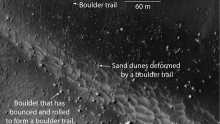One of the more strikingly obvious facts is that some of the surface-smoothing lava flows are actually much younger than previously believed; 2 million years old in some cases which is near-infancy on a geological timeline. However, it’s still not enough to indicate that Mars is still generating heat under the surface. Two million years is long enough to prove extinction of a volcano, and its eruption could have been the swan song of the planet’s seismic activity.
However, thanks to the higher resolution capabilities of cameras, which are able to see objects only six feet across, scientists are now looking at boulders for evidence of seismic activity; principally rolling boulders. In the Cerberus Fossae (Cerberus fracture: so named for three large parallel fissures) area of Mars, near the enormous Elysium Mons (mountain), there is substantial evidence of seismic activity from rolling boulders. Following the same principle of earthquakes, which can dislodge and cause boulders to roll downhill, large Martian boulders seem to be rolling down through the Martian equivalent of sand dunes, creating long, linear trails through the dust.
That’s not to say that there couldn’t be some other reason for these migrating boulders. One hypothesis was that the boulders may have been frozen in place by ice deposits that, loosened by mid-day sunlight, allowed the boulders to tumble. Gerald Roberts, leader of a team of scientists from the University of London, tells TIME magazine, “The ice-melting hypothesis is not supported.”
The discovery of seismic activity on Mars is a significant one because it leave open the possibility that Mars may still be generating its own heat, much like the core of the Earth. If that’s true, then it’s also likely that the water beneath mars’ surface may not all be ice, but some liquid water as well. As they say, where there is water, there is life, and this opens up the possibility of some life, perhaps single-celled bacteria that excrete methane (which has also been detected on Mars’ surface), lurking underneath.
